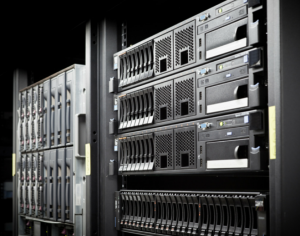 As companies expand and increase their workload, there can be a growing need for IT infrastructure. Servers might be considered to store files or run applications.
As companies expand and increase their workload, there can be a growing need for IT infrastructure. Servers might be considered to store files or run applications.
We also have to consider technology start-ups and small businesses that need server space to test and run applications they’re developing. The trouble is the cost of server infrastructure isn’t cheap. In fact it’s quite the opposite when you take the full list of factors into account.
Not only do you have to consider the servers (how does it need to be optimised? Compute? Storage? Memory?), you have to consider the software, the room for the servers, appropriate storage racks, cabling, electricity and vitally, cooling.
If your company is at a growth stage, it’s likely you will keep growing for the foreseeable future, which could mean more servers and more space needed. As you expand your server numbers, you need extra hands to maintain them meaning more salaries to pay.
It all stacks up to be a huge cost that continues to increase as the company expands. But with cloud computing, you can eliminate these unnecessary infrastructure costs and stay on top of your spending.
Growth and expansion is a good thing, but wastage, and expanding faster than the company can afford is damaging.
IaaS is the Answer
Infrastructure as a Service (IaaS) can effectively eliminate the cost of hosting server hardware. There isn’t the same need to maintain the servers and there is no upfront cost for the servers.
Using cloud servers also means the server room that you would have needed can become a meeting room or extra office space, or even better, a games room with a pool table and comfy chairs.
Either way, what could have been considered a very expensive room that hosted your servers and needed to be kept cool with additional cooling units can now be freed up in terms of both cost and space.
IaaS also supports growth, arguably in a more viable and affordable way than server hardware. To spin up new servers costs a fraction of the price and scaling can be achieved easily as needed.
What infrastructure do you need for the Cloud?
You need a computer and good Internet. There isn’t much more to it.
Using cloud services such as Amazon Web Services allows you to spin up a server as and when you need, use it for as long as you need and then close it down again.
Disaster Recovery and Continuity
Another consideration many businesses make when expanding is disaster recovery and continuity planning. If you’re housing all of your data and applications on locally hosted servers and a fire or flood or earthquake happens, there is the potential for loss of data.
Because of this, back-up servers hosted elsewhere may need to be thought about. If this is something the company, again, decides to invest in hardware for, the cost rises.
Cloud computing once again eliminates this need for extra infrastructure. There is a lot less chance of something happening to the server farm that Amazon host compared to the small server room you might have in the back.
How Cloud Computing Eliminates Infrastructure Costs
Cloud computing isn’t the answer to everyone’s problems. There will still be barriers for some companies, for example compliance and regulations around data and where files are stored can persuade businesses to stick with local hardware.
But, for a technology start-up or small business who need to keep an eye on capital expenditure, cloud computing is the way to eliminate infrastructure costs and still gain access to the computing power and storage they need for their business.
Developers can spin up servers of different sizes as and when they need them without the hassle of investing time and effort in setting up new hardware on-site. Whilst eliminating infrastructure costs, cloud computing also offers the scalability that many businesses look for when expanding.
Learn how Cloud Machine Manager could be saving you money on AWS costs and see how much you could save with our savings estimator.

